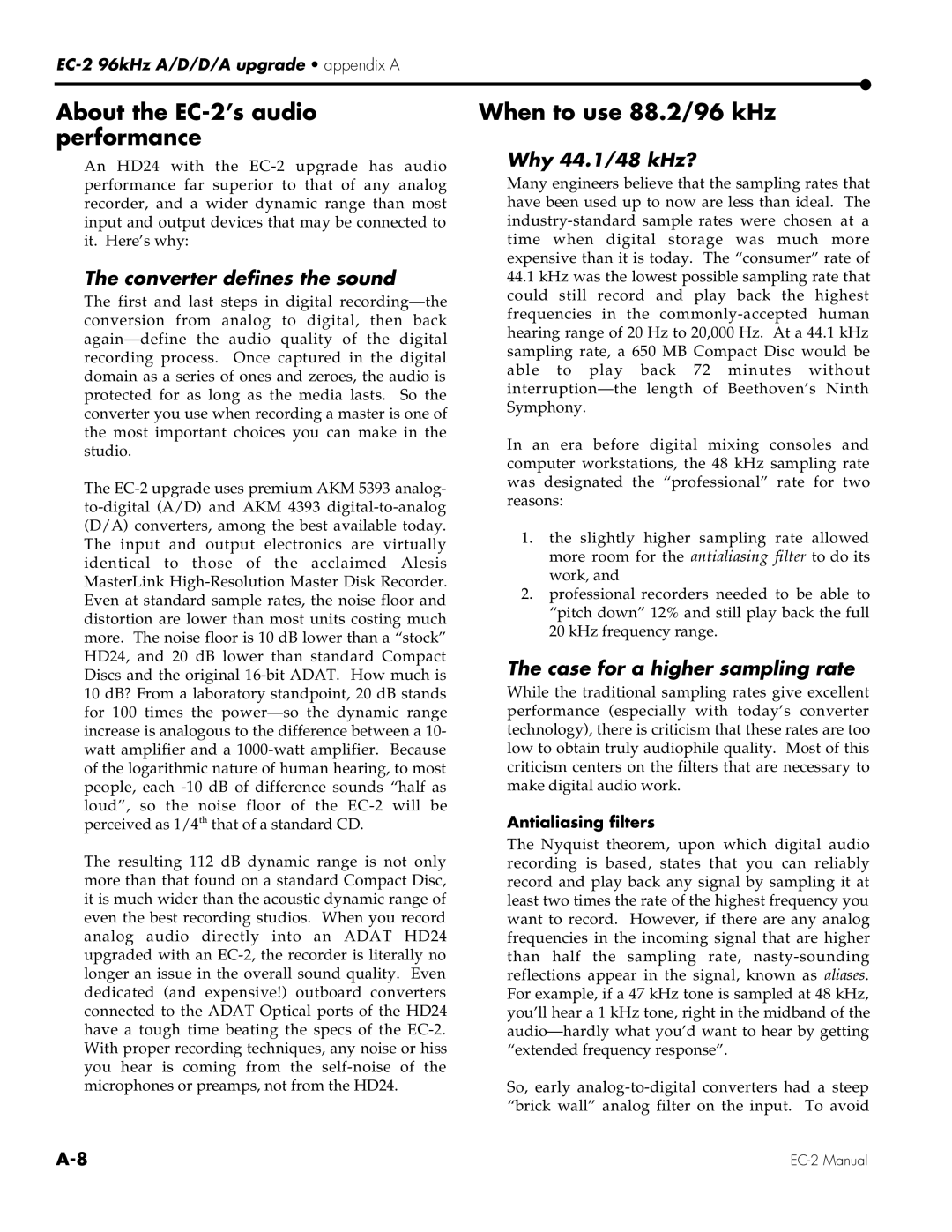About the EC-2’s audio performance
An HD24 with the EC-2 upgrade has audio performance far superior to that of any analog recorder, and a wider dynamic range than most input and output devices that may be connected to it. Here’s why:
The converter defines the sound
The first and last steps in digital recording—the conversion from analog to digital, then back again—define the audio quality of the digital recording process. Once captured in the digital domain as a series of ones and zeroes, the audio is protected for as long as the media lasts. So the converter you use when recording a master is one of the most important choices you can make in the studio.
The EC-2 upgrade uses premium AKM 5393 analog- to-digital (A/D) and AKM 4393 digital-to-analog (D/A) converters, among the best available today. The input and output electronics are virtually identical to those of the acclaimed Alesis MasterLink High-Resolution Master Disk Recorder. Even at standard sample rates, the noise floor and distortion are lower than most units costing much more. The noise floor is 10 dB lower than a “stock” HD24, and 20 dB lower than standard Compact Discs and the original 16-bit ADAT. How much is 10 dB? From a laboratory standpoint, 20 dB stands for 100 times the power—so the dynamic range increase is analogous to the difference between a 10- watt amplifier and a 1000-watt amplifier. Because of the logarithmic nature of human hearing, to most people, each -10 dB of difference sounds “half as loud”, so the noise floor of the EC-2 will be perceived as 1/4th that of a standard CD.
The resulting 112 dB dynamic range is not only more than that found on a standard Compact Disc, it is much wider than the acoustic dynamic range of even the best recording studios. When you record analog audio directly into an ADAT HD24 upgraded with an EC-2, the recorder is literally no longer an issue in the overall sound quality. Even dedicated (and expensive!) outboard converters connected to the ADAT Optical ports of the HD24 have a tough time beating the specs of the EC-2. With proper recording techniques, any noise or hiss you hear is coming from the self-noise of the microphones or preamps, not from the HD24.
When to use 88.2/96 kHz
Why 44.1/48 kHz?
Many engineers believe that the sampling rates that have been used up to now are less than ideal. The industry-standard sample rates were chosen at a time when digital storage was much more expensive than it is today. The “consumer” rate of
44.1kHz was the lowest possible sampling rate that could still record and play back the highest frequencies in the commonly-accepted human hearing range of 20 Hz to 20,000 Hz. At a 44.1 kHz sampling rate, a 650 MB Compact Disc would be able to play back 72 minutes without interruption—the length of Beethoven’s Ninth Symphony.
In an era before digital mixing consoles and computer workstations, the 48 kHz sampling rate was designated the “professional” rate for two reasons:
1.the slightly higher sampling rate allowed more room for the antialiasing filter to do its work, and
2.professional recorders needed to be able to “pitch down” 12% and still play back the full 20 kHz frequency range.
The case for a higher sampling rate
While the traditional sampling rates give excellent performance (especially with today’s converter technology), there is criticism that these rates are too low to obtain truly audiophile quality. Most of this criticism centers on the filters that are necessary to make digital audio work.
Antialiasing filters
The Nyquist theorem, upon which digital audio recording is based, states that you can reliably record and play back any signal by sampling it at least two times the rate of the highest frequency you want to record. However, if there are any analog frequencies in the incoming signal that are higher than half the sampling rate, nasty-sounding reflections appear in the signal, known as aliases. For example, if a 47 kHz tone is sampled at 48 kHz, you’ll hear a 1 kHz tone, right in the midband of the audio—hardly what you’d want to hear by getting “extended frequency response”.
So, early analog-to-digital converters had a steep “brick wall” analog filter on the input. To avoid
